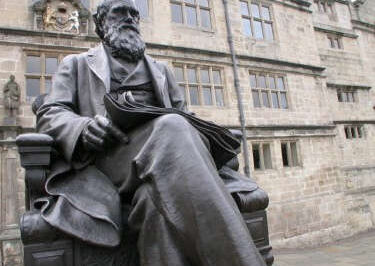
When Charles Darwin advanced his theory of biological evolution, there was a lot of biology he didn’t know. Some of it he recognized. But there was much he never even thought about.
During the 150 years since then, scientific advance has yielded important understanding about life’s origin, history and characteristics. These accomplishments provide the framework for modern biology. Even more, they are causing scientists to question his theory. Learning what scientists know will equip Christians with a response to the Darwin anniversaries and his theory of biological evolution that can change minds and lives.
Darwin didn’t address life’s start in his seminal work, The Origin of Species. However, in 1871, while writing to a friend, Darwin speculated that the first spark of life may have taken place in a “warm little pond, with all sorts of ammonia and phosphoric salts, lights, heat, electricity, etc. present, so that a protein compound was chemically formed ready to undergo still more complex changes.”
Still, it took until the 1920s before Russian biochemist Alexander I. Oparin and British geneticist J.B.S. Haldane independently provided a comprehensive scientific hypothesis for abiogenesis (life coming from nonlife) based, in part, on Darwin’s musings. Providing detailed pathways from inorganic systems on primordial Earth to the first living entities, the Oparin-Haldane hypothesis postulated an atmosphere without oxygen. Instead, reducing gases-hydrogen, ammonia, methane and water vapor-supposedly dominated. Energy discharges formed simple organic (prebiotic) molecules that accumulated in Earth’s oceans to brew the primordial soup. There, presumably, chemical reactions led stepwise to life’s first forms.
In the 1950s Stanley Miller provided what many considered the first experimental verification of this hypothesis. By passing an electrical discharge through a reducing gas mix, Miller produced amino acids and other organics. His success launched the origin-of-life research program and became standard textbook fare.
These now-famous experiments inaugurated a series of experiments by others that seemingly provided ongoing support for Oparin’s and Haldane’s ideas. Giddy with Miller’s accomplishment, many scientists predicted the origin-of-life problem would soon be solved. But several recent discoveries have diminished that confidence.
Miller’s Experiment Didn’t Matter
Few textbooks acknowledge that today most origin-of-life researchers consider Miller’s experiment irrelevant. Strong evidence revealing a primordial atmosphere composed of carbon dioxide, nitrogen and water has changed the scientific consensus. This gas mixture does not yield organic compounds in laboratory prebiotic simulation experiments-a devastating blow for the evolutionary scenario.
In the May 2, 2003, issue of Science, Jeffrey Bada and Antonio Lazcano, Miller’s long-time collaborators, commemorated the 50th anniversary of his experiment. While explaining its
historical interest, they acknowledged that “contemporary geoscientists tend to doubt that the primitive atmosphere had the highly reducing composition used by Miller in 1953.”
Equally problematic is the lack of any evidence for a prebiotic soup. If life arose from a chemical stew, then Earth’s oldest rocks should bear that soup’s chemical residue. Yet, according to origin-of-life researcher Noam Lahav in Biogenesis, so far, no geochemical evidence for the existence of a prebiotic soup has been published. Life could not arise from a primordial soup that never existed.
Life’s Amazing Design
Researchers have traditionally maintained that hundreds of millions of years would be necessary for abiogenesis. They also claim that the first life to emerge would be extremely simple, evolving toward complexity.
Darwin embraced the protoplasmic theory-the idea that the cell consisted of only a wall surrounding a nucleus and a homogeneous, jellylike protoplasm. This understanding made early evolutionary explanations of abiogenesis plausible. Biologists and chemists easily envisioned chemical routes that could produce the single ingredient believed to form the cell’s protoplasm.
By the end of the 19th century, however, this concept waned. With the discovery of enzymes in the cell’s protoplasm capable of catalyzing a large collection of chemical reactions, scientists recognized protoplasm as a complex heterogeneous system.
During the last century, advances in biochemistry continue to affirm the complexity of life at a molecular level. Even the simplest bacterium requires nearly 2,000 different proteins in the “protoplasm” to exist as a living entity. Not only are the cell’s chemical systems irreducibly complex, but they also display an extraordinary degree of order undergirded by an elegant, sophisticated logic.
Biochemists have also discovered that the salient characteristics of biochemical systems are identical to features immediately recognizable as the product of human designers. This close match logically compels the conclusion that life’s most fundamental processes and structures stem from the work of an intelligent Agent.
Many of the proteins that operate in the cell function as molecular-level machines. And many bear a striking resemblance to man-made machines replete with drive shafts, camshafts, turbines, clamps, lever arms, bushings, stators and rotors.
Even atheists agree that life’s chemical systems appear designed. The late Francis Crick, who shared the Nobel Prize for discovering the structure of DNA, cautioned in What Mad Pursuit that “biologists must constantly keep in mind that what they see was not designed, but rather evolved.” By all appearances, life’s chemistry looks like the product of a Creator.
Because common experience teaches that information and codes always emanate from a mind, new discoveries about the information systems in the cell and the genetic code refute Darwin’s theory while providing powerful evidence for the work of an intelligent Agent.
Necessary to give meaning to the information stored in DNA, the genetic code supplies rules used by the cell’s machinery to make proteins that also harbor information. Additionally, biochemists have recently learned that these rules are optimally fine-tuned. Given the time scale for the origin of life, natural selection would have had to evaluate roughly 1055 codes per second to find the genetic code. On this basis alone, it couldn’t have an evolutionary origin. There simply wasn’t enough time for natural processes to stumble upon it.
Fossil Record Finds
Darwin knew that the fossil record didn’t offer much support for his ideas. In The Origin of Species, he devoted a chapter to the “difficulties,” with two features considered most troubling: the absence of transitional forms and the abrupt appearances of biological groups the first time they occurred in the fossil record.
Darwin lamented that “by this theory innumerable transitional forms must have existed, why do we not find them embedded in countless numbers in the crust of the earth?”
Convinced that the fossil record was incomplete, Darwin expected missing transitional forms and gradual evolutionary transformations to be uncovered over time by paleontologists. And indeed they have found fossils that supply two key pieces of evidence to support biological evolution.
The fossil record shows that past life is different from life today and simple life preceded complex. For many scientists these features indicate life must have evolved.
But the work of a Creator, who brought different life forms into existence at different times, could just as easily account for these factors. The Genesis 1 and Psalm 104 creation accounts record this pattern.
Despite all discoveries, the overall features of the fossil record still look the same today as in Darwin’s time. Transitional forms are scarce. When new biological groups appear in the fossil record, they show up explosively, then undergo little change.
Perhaps the chief example of sudden appearances is the Cambrian explosion. About 540 million years ago complex marine organisms exploded into the fossil record. Instead of relatively simple organisms originating at the base of the Cambrian, then evolving toward increased intricacy, complex animals appeared early and suddenly.
Evolutionary biologists struggle to account for this because they believe life transitioned from simple to complex in a gradually branching, treelike fashion. Yet explosive appearances are exactly what to expect if a Creator orchestrated life.
In The Blind Watchmaker atheist Richard Dawkins admits: “The Cambrian strata of rocks, vintage about 600 million years, are the oldest ones in which we find most of the major invertebrate groups … many of them already in an advanced state of evolution, the very first time they appear.”
Such explosive appearances dominate the fossil record. Every time biological innovation occurs, it happens explosively. A big bang occurred when life first appeared, when the first complex cells originated and when animal body plans arose.







Leave a Comment
You must be logged in to post a comment.